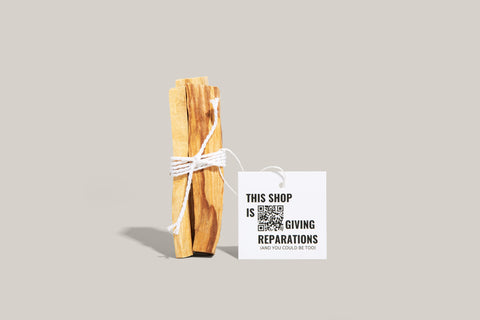

Cosakait (Palo Santo) Bundle
Cosakait (pronounced “koh-sah-kite”) is the Toba word for Palo Santo, a sacred wood traditionally used for cleansing, protection, and uplifting the spirit. Its scent is sweet, woody, and citrusy, with warm balsamic undertones—burned to dispel emotional heaviness, clear stagnant energy, and invite peace and renewal.
In Toba oral tradition, Cosakait was a virtuous young man whose unreturned love left him gravely ill. Before he passed, he prayed to Yago (God) that his spirit might remain on Earth to care for the one he loved. From his grave grew a fragrant tree—its wood became the sacred Palo Santo, a symbol of love, protection, and enduring kindness.
These restorative qualities are also present in the tree’s physical properties. Research shows that Palo Santo contains essential oils rich in limonene and α-terpineol—compounds with antioxidant, anti-inflammatory, and mood-balancing effects. These plant properties support emotional clarity and energetic protection, offering a gentle sense of grounding with every breath of its sacred smoke.
📦 BUNDLE SPECS
-
Approximately 4 inches in length
-
Hand-harvested from naturally fallen trees in South America
-
Sustainably sourced by an Indigenous-owned company
-
Packaged with a tag noting your contribution to reparative justice
📜 HISTORY OF COLONIZATION
-
Spanish Conquest of the Gran Chaco (16th–18th centuries): Sanctioned by the Papal Bull Inter Caetera (1493) and enforced through the Requerimiento (1513), Spain launched military campaigns against Indigenous nations like the Toba, Wichí, and Ayoreo. These actions were framed as divine missions to convert and civilize, leading to widespread violence and dispossession.
-
Encomienda & Forced Labor Systems: The encomienda system allowed Spanish settlers to extract labor from Indigenous peoples under the guise of protection and religious instruction. This evolved into debt peonage, where Indigenous communities were bound to labor through indebtedness, particularly in agriculture and resource extraction.
-
State-Sanctioned Land Seizure & Displacement: Under the Doctrine of Discovery, the Spanish Crown claimed Indigenous lands for missions and settlers. After independence, Argentina, Bolivia, and Paraguay continued this process by selling Gran Chaco forests to ranchers, timber companies, and settlers. These actions displaced Indigenous nations like the Toba and Ayoreo from their ancestral territories.
-
Deforestation & Industrial Exploitation: Following land dispossession, Gran Chaco forests—home to Palo Santo—were rapidly cleared for cattle ranching, soy monoculture, and timber extraction. These industries degraded biodiversity, disrupted ceremonial plant harvesting, and severed Indigenous relationships with the land. Today, the Gran Chaco remains one of the most deforested regions in the world, with Palo Santo habitats increasingly endangered.
⚖️ REPARATIVE JUSTICE EFFORTS
-
Siekopai Nation Land Reclamation (2023): After decades of displacement, the Siekopai Nation reclaimed 42,000 hectares of ancestral rainforest in Ecuador. This historic victory reverses colonial land theft and restores Indigenous sovereignty over biodiverse territories where Palo Santo trees grow.
-
Waorani Legal Defense Against Oil Drilling (2019): The Waorani people secured a court ruling that blocked oil drilling across 180,000 hectares of their territory. The ruling upheld their right to free, prior, and informed consent, reaffirming Indigenous authority over sacred lands.
-
Inter-American Court Ruling on Uncontacted Tribes (2025): The Inter-American Court of Human Rights ordered Ecuador to protect the rights of uncontacted Indigenous peoples from industrial encroachment, reinforcing international recognition of Indigenous land stewardship.
- Ethical Harvesting & Indigenous-Led Enterprises: In Ecuador and Peru, Indigenous cooperatives are advancing regenerative practices by harvesting only naturally fallen Palo Santo and investing in reforestation. These practices combat extractive industry norms and reestablish cultural ties to sacred medicine.
